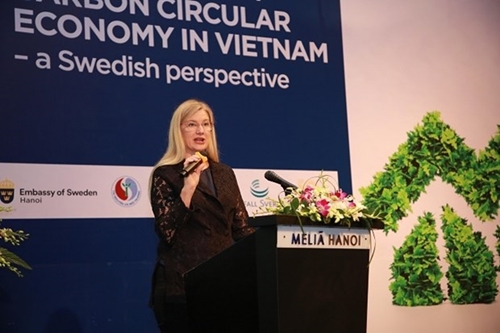Deputy Minister of Natural Resources and Environment Vu Tuan Nhan, told the workshop that after a long time of depending on and spending natural resources, Vietnam has made significant improvements in its socio-economic conditions. However, the country has had to trade off economic growth for environmental change and pollution.
“Transforming the current economic model to the circular economy is a suitable action that Vietnam is striving for so that it achieves the sustainable development goals,” he said.
Swedish Ambassador Ann Mawe said a circular economy will benefit both consumers and businesses.
    |
 |
|
Swedish Ambassador to Vietnam Ann Mawe speaks at the workshop. |
She said, “Companies that are moving in this direction have proved that recycling used products can be more cost effective than creating them from scratch.
“Production costs are reduced, so the sale price is also lowered, thereby benefiting the consumers. I hope this is inspiring for Vietnamese businesses,” said the ambassador.
The two officials stressed that private firms should be called for deeper participation in the development of the circular economy.
According to Nguyen Hoang Nam from the Ministry of Natural Resources and Environment (MoNRE), World Bank in 2019 estimated that the impacts of environmental pollution might cut off 3.5 percent from Vietnam's GDP in 2035.
Other statistics were also provided to prove the traditional linear economy was hampering natural resources, increasing waste volume and pulling down the world’s socio-economic development.
“The statistics create a big question whether we are moving forward or backwards with the current economic model,” said Nam, who is also an official at the Institute of Strategy and Policy on Natural Resource and Environment.
He said because of this it is important to promote the implementation of a circular economy to preserve and develop natural capital through rational use and re-generation of resources and use of renewable energy.
In addition, it would optimize the yield of resources and materials as much as possible in production cycles, and improve the overall system performance by minimizing negative externalities through waste design, he said.
Source: VNA